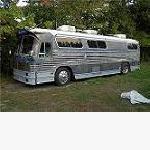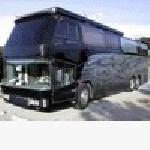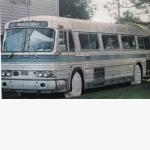| Author | Message | ||
| Jim Sanders (Sandy)
Registered Member Username: Sandy Post Number: 58 Registered: 1-2011 Posted From: 69.199.96.250  Rating: N/A |
I would like some info. on isolaters I use C world Elect. isolaters with diodes Would relays be better?????? | ||
| George M. Todd (George_todd)
Registered Member Username: George_todd Post Number: 1251 Registered: 8-2006 Posted From: 99.37.28.23 Rating: N/A |
Oh boy, is this going to stir up things! Isolators cause a 0.6 Volt drop across them, and regardless of what some non-qualified people say, the house and the chassis batteries charge at the same voltage. Its simple Ohm's law, both sides go through a diode, so the resistance is the same. An isolator having 200 Amps run through it will waste 120 Watts as heat. Once your batteries are charged, and you are running 25 Amps thru it, the loss is down to 15 Watts. The easy thing about isolators, is that you just cut the output cable from the stock bus alternator, connect the isolator input to the alternator output, and the chassis batteries to one output terminal, and the house batteries to the other, and you're done. Mount it in the open, with the fins vertical. The bad thing about isolators, is that they can't be wired to have the house batteries help the chassis batteries with an emergency start. Using a 200 Amp continuous duty solenoid to do the joint charging and separating works well, just use large enough cable. Wire the coil terminal thru the master switch for the simplest control. When the master is on, the batteries are joined. The bad thing about that is discharged house batteries are connected to your starting batts when you start. So, if your bus has an 'R' terminal, connect the relay coil terminal there, and you won't have join unless you have charge. You can also add a button between the master and the coil for emergency start, or a SPDT switch with one side momentary to do the same thing. G | ||
| Jim Sanders (Sandy)
Registered Member Username: Sandy Post Number: 59 Registered: 1-2011 Posted From: 69.199.96.250  Rating: N/A |
George I own a 1983 Holiday rambler RV Bought in 1988. I live in the HR full time so i am connected to elect Bought a 1968 flxliner last year. I am working on the flx. RUST RUST So will i ever finish?? who knows!!! The rv is set up with a CW Diode With a solenoid aux startThe biggest problem that i have is keeping the house battery from over charging (burn up) Would like to have something better for the Flx. I run a kitchen timer for the RV Works fair (cheap) But still gives problems... I think i understand A R term to Energize the alt coil ???? G Must go now more info later i hope Jim | ||
| Jim Sanders (Sandy)
Registered Member Username: Sandy Post Number: 60 Registered: 1-2011 Posted From: 69.199.96.250  Rating: N/A |
George Another queston for you.. Should the house batt charger and main eng.alt. be working at the same time?????? Jim | ||
| Sean Welsh (Sean)
Registered Member Username: Sean Post Number: 1264 Registered: 1-2003 Posted From: 68.53.237.136  Rating: N/A |
We've covered this ground many times before. See my comments here: http://www.busnut.com/bbs/messages/11/39368.html#POST152907 Later in that same thread I discuss why you should generally not bridge banks while the three-stage charger is running: http://www.busnut.com/bbs/messages/11/39368.html#POST152929 -Sean http://OurOdyssey.BlogSpot.com | ||
| Jim Sanders (Sandy)
Registered Member Username: Sandy Post Number: 61 Registered: 1-2011 Posted From: 69.199.96.250  Rating: N/A |
sean you have confused me too... A relay with timer built in Installed between Battery bank and fields in alt.Lets the Alt. build up RPM before it starts charging.Right or Wrong??? A solinad tyes 2or more bat.banks together (2 max) This i understand How you will tye a chg. circut in I dont. uhless you tye it in with one or other bat. banks Sean if you will make a schmatic I will buy one | ||
| Sean Welsh (Sean)
Registered Member Username: Sean Post Number: 1265 Registered: 1-2003 Posted From: 67.142.130.30  Rating: N/A |
The delay timer is not on the field circuit. It is on the bridge solenoid that ties the two banks together. This keeps the house bank separate from the chassis bank until after the engine is fully started and up to speed. All of my schematics are on our photo site: http://Odyssey.SmugMug.com -Sean http://OurOdyssey.BlogSpot.com (Message edited by Sean on July 02, 2011) | ||
| Jim Sanders (Sandy)
Registered Member Username: Sandy Post Number: 62 Registered: 1-2011 Posted From: 69.199.96.250  Rating: N/A |
Sean I think i have seen the light!!!! Please correct me if i am wrong...Use one solenoid to bridge both banks together.. Have 2 switches to activate the solenoid One switch mounted on dash for Aux start The other on the engine when it is running... Where?? Oil psi.(cant spell pressur) I dont think I like that???? dont know why!!! A time delay relay Might work better????? For eng switch. How much delay??? Or your run switch on dash.. Sean i think the double switch will work???? Aux start i use a push butten on dash no danger of forgetting it Sean please give me your thoughts on this??? LOL Jim | ||
| Jim Sanders (Sandy)
Registered Member Username: Sandy Post Number: 63 Registered: 1-2011 Posted From: 69.199.96.250  Rating: N/A |
Sean I think i have seen the light!!!! Please correct me if i am wrong...Use one solenoid to bridge both banks together.. Have 2 switches to activate the solenoid One switch mounted on dash for Aux start The other on the engine when it is running... Where?? Oil psi.(cant spell pressur) I dont think I like that???? dont know why!!! A time delay relay Might work better????? For eng switch. How much delay??? Or your run switch on dash.. Sean i think the double switch will work???? Aux start i use a push butten on dash no danger of forgetting it Sean please give me your thoughts on this??? LOL Jim | ||
| Sean Welsh (Sean)
Registered Member Username: Sean Post Number: 1266 Registered: 1-2003 Posted From: 68.53.237.136  Rating: N/A |
Jim, You could use two switches, as you suggest, or a single double-throw switch. If you get a double-throw switch with one momentary contact and a center-off position, you will have a way to do emergency start, normal operation, or disconnect the two systems altogether. The momentary, emergency-start side goes to a source 12v power that is hot all the time. The other side goes to a 12v signal that is hot only when the engine is actually running (not just ignition-on). I can't tell you where to find such a signal on your specific bus, but perhaps others here can. On many buses, there is a circuit that is hot only when the alternator is putting out charge. This circuit is used to operate the "Not Gen" or "No Charge" lamp should the alternator fail, and on buses with air conditioning it is also used to run the electric blowers. Some buses have a circuit that is hot when there is oil pressure, or fuel pressure. If you need to "roll your own" you can make an alternator circuit by connecting a 6-volt relay to the "R" terminal on the alternator, and use the output contacts to switch a 12v signal. You can make an oil pressure circuit by connecting a 12v relay between a +12v source and a grounding-type oil pressure sender, and use the output of that relay to switch a 12v signal. In either case, the signal will go "hot" before the engine is done cranking, which is why I recommend adding a short time delay to this signal if you can. A different way to accomplish this is to add a relay at the starter circuit, and use the NC contacts to ensure that the bridge signal does not connect until the starter is released. Make sense? -Sean http://OurOdyssey.BlogSpot.com | ||
| Jim Sanders (Sandy)
Registered Member Username: Sandy Post Number: 64 Registered: 1-2011 Posted From: 69.199.96.250  Rating: N/A |
Sean The flx of mine has so much rust in the framing iam stii cutting out rust hope to be finished the finished in the next 6to8month doing it myself this wireing is something that has been on my mind.!!!!! I have wanted to send you guys some pictures but so far no luck get there later... I have never thought 0f fuel pressure. Fuel has a constent pressure or will have..... Min. 10psi (I think) Going to the pump on eng. Elect.pump But i think i better make a seperate thd. on that one Sean i am verry thrilled of the answers i have gotten on this!!!! Are you guys supposed to know EVERY THING..A great big LOL JIM | ||
| FAST FRED (Fast_fred)
Registered Member Username: Fast_fred Post Number: 1556 Registered: 10-2006 Posted From: 76.194.81.248  Rating: N/A |
The nicest , almost invisible setup is to use a key start switch as used on most RV. The solenoid is closed by the AUX terminal , so no operator effort is required for normal operation. I would install a boat rotary SWITCH if an emermency start connection is desired. Most RV solenoids are only 75A , and even 3 in parallel would be poor at cranking a cold diesel. The best boat stuff will do 2000A on an intermittant basis. But then a short set of booster cables would be OK too since its only an emergency setup that may never be required. The auto style key switches can be had in higher amp ratings with silver contacts from Cole Hersey . When plugged into outside power the start switch cam be left in ACC to charge the start batt from the house set that usually has the charger. * What is not installed does not have to be purchased , installed or maintained. KISS FF |